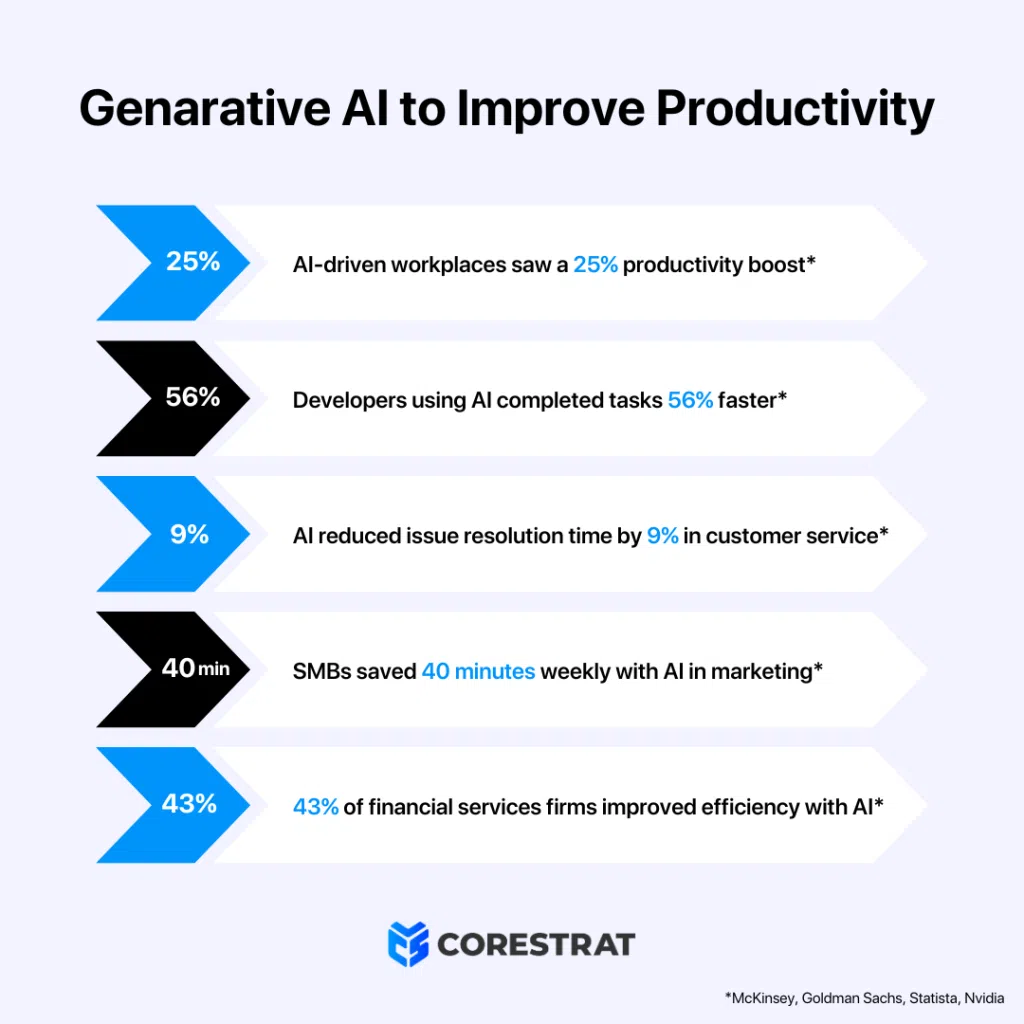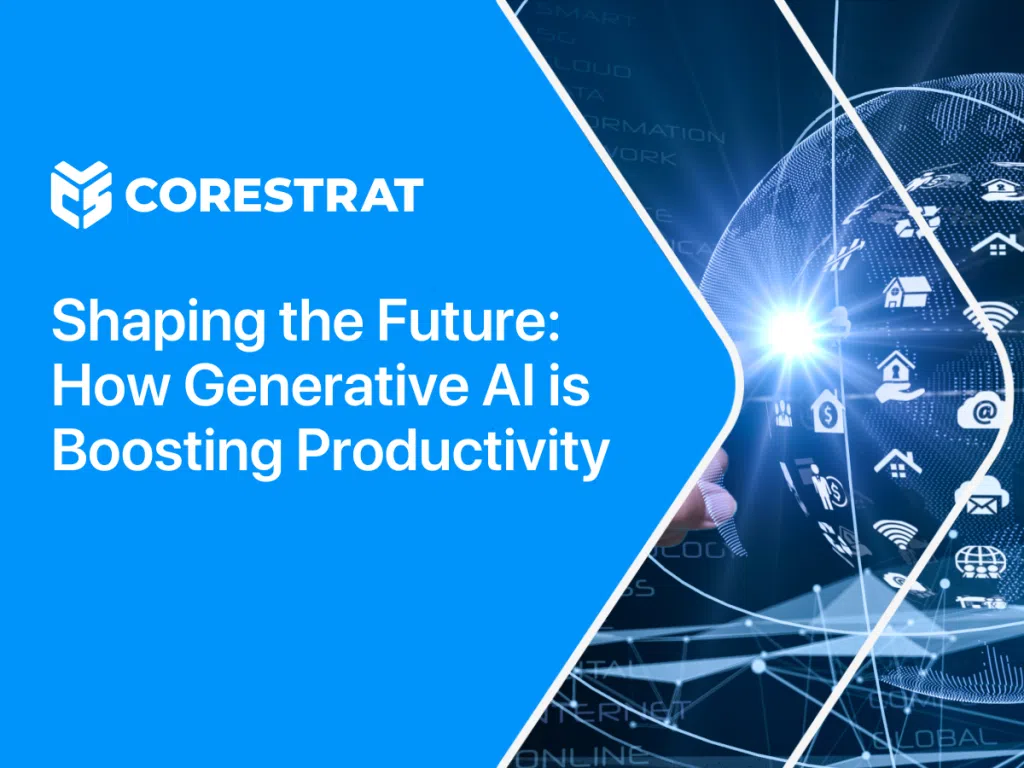Productivity and profitability are at the heart of every organisation’s goals. They’re the driving forces behind countless strategies, innovations, and efforts to improve and grow. In this relentless pursuit of doing more and doing better, generative AI has emerged as a game-changer—a tool that’s transforming industries and empowering teams to work in ways we couldn’t have imagined just a few years ago.
What was once a term reserved for tech enthusiasts, generative AI has now become a powerful ally for businesses of all sizes. From creating captivating marketing campaigns to simplifying complex workflows, it has evolved from being an experimental concept to a practical, everyday tool. And as organisations continue to explore how to enhance efficiency, creativity, and productivity, generative AI is proving to be the missing piece in the puzzle.
In this article, we’ll dive into how generative AI is reshaping the way we work, driving improvements across industries, and helping people and businesses unlock their full potential. Let’s explore the human side of this transformative technology and how it’s making work not just smarter, but also more fulfilling.
Enhancing Productivity with Generative AI
Generative AI’s capability to manage repetitive and time-intensive tasks allows employees to concentrate on strategic, high-value work. Organisations implementing AI in the workplace have reported an average productivity increase of approximately 25%, with studies suggesting this figure will rise as generative AI continues to evolve in the coming years.
Here’s how it boosts productivity:
1. Streamlining Administrative Tasks
Today’s generative AI powered platforms can automate a significant portion of work, potentially streamlining 60% to 70% of tasks that currently consume employees’ time. These technologies excel at handling repetitive, time-consuming activities such as scheduling meetings, drafting agendas, or summarising lengthy documents. For instance, tools like Otter.ai offer transcription and summarisation services that save professionals countless hours of manual effort, allowing them to focus on more meaningful and strategic work. As these tools continue to improve, they are poised to make work more efficient and less burdensome for everyone.
2. Real-Time Decision Support
AI models excel at analysing extensive datasets in real time to deliver actionable insights that drive efficiency and informed decision-making. In the retail sector, for example, AI can forecast inventory needs by analysing historical sales patterns and current market demand, enabling businesses to maintain optimal stock levels and ensure seamless operations.
Advanced solutions like Corestrat’s ID.ai take this a step further by processing vast quantities of data in real time, facilitating decision automation for users. By doing so, these systems not only reduce the time and costs associated with decision-making but also enhance accuracy and operational agility.
3. Personalised Employee Training
Generative AI can create customised training modules based on an individual’s learning curve. Platforms like Coursera and Udemy use AI to recommend courses tailored to user preferences, making upskilling more effective.
4. Creative Collaboration
Generative AI acts as a brainstorming partner for creative teams. Whether it’s developing storylines, designing products, or crafting innovative solutions, AI ensures that creative processes are faster and more efficient. Architects are using generative AI tools like Autodesk’s Generative Design to explore thousands of design permutations, selecting optimal solutions based on sustainability, cost, and aesthetics.

Applications of Generative AI in the Workplace
1. Content Creation and Marketing
Generative AI tools like ChatGPT, Jasper, and Copy.ai are empowering marketers to produce high-quality content at scale with remarkable ease. These platforms can generate blog posts, write ad copy, craft social media content, and even design personalised email campaigns—all in a fraction of the time that traditional methods require.
A notable example of this innovation is Coca-Cola’s collaboration with OpenAI for its “Create Real Magic” campaign. This initiative allowed fans to use AI to create their own Coca-Cola-themed artwork, blending the magic of creativity with advanced technology.
A study on the use of AI in marketing found that 33% of small and medium-sized businesses (SMBs) were able to save between 26 to 40 minutes each week by integrating AI into their marketing tasks. These time savings may seem modest, but they accumulate quickly, enabling teams to focus on higher-value activities and drive greater impact with less effort.
2. Customer Service Automation
A study found that at a company with 5,000 customer service agents, introducing generative AI boosted issue resolution by 14% per hour and cut the time spent on each issue by 9%. Generative AI-powered chatbots, like those built using Microsoft Azure OpenAI or Google’s Dialogflow, are taking customer service to the next level. These bots handle customer inquiries 24/7, quickly resolve complaints, and provide personalised solutions—offering seamless support without the need for human intervention.
GenInsight.ai by Corestrat is another excellent example of a generative AI-powered tool to help with accelerating informed decision-making. It functions not only as a chatbot, but also it helps users of Corestrat’s product platforms find the answers they need.
3. Software Development
Developers are increasingly using tools like GitHub Copilot to write, debug, and optimize code more efficiently. These AI-powered systems can understand natural language prompts and convert them into functional code, greatly speeding up the development process. In fact, a study found that software developers using Microsoft’s GitHub Copilot completed tasks 56% faster compared to those who didn’t use the tool.
4. Healthcare Advancements
Generative AI is revolutionising diagnostics, personalised medicine, and research. AI models analyse patient data to suggest tailored treatment plans or generate synthetic data for training purposes, preserving privacy while improving model accuracy. Google DeepMind’s AlphaFold uses AI to predict protein structures, which has accelerated research in drug discovery and disease understanding.
5. Finance and Risk Analysis
Studies reveal that 43% of financial services organisations have successfully boosted their operational efficiency through AI, giving them a competitive advantage while freeing up valuable resources to focus on key areas like customer engagement and innovation. Financial institutions are increasingly adopting generative AI to automate critical tasks such as fraud detection, financial report generation, and market scenario simulations.
By harnessing AI-driven insights, these organisations can enhance risk management, accelerate decision-making, and optimise overall efficiency. From decision management systems that analyse alternative data for credit risk assessment to loan origination systems that streamline automated lending, generative AI has become a vital tool in the financial sector, helping to mitigate risk and improve operational performance.
Conclusion
Generative AI is not just reshaping the workplace; it is setting the stage for a future where innovation and productivity thrive. By automating mundane tasks, enhancing creative processes, and providing real-time insights, generative AI empowers businesses and individuals to reach new heights. However, with great power comes great responsibility. Addressing ethical challenges and fostering AI-human collaboration will be critical in realising the full potential of this transformative technology.
As generative AI continues to evolve, the question is no longer whether it will transform work, but how we can best prepare to embrace and maximise its possibilities. The future of work, fueled by generative AI, is here—and it is both exciting and boundless.
 Skip to content
Skip to content



